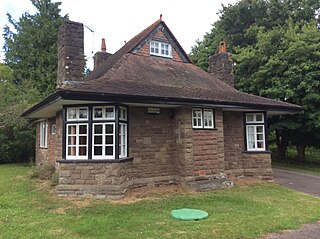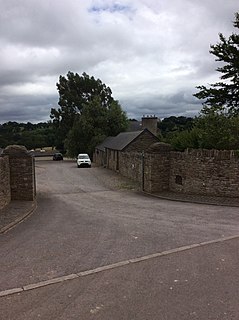
The Hendre, in Rockfield, is the only full-scale Victorian country house in the county of Monmouthshire, Wales. The ancestral estate of the Rolls family, it was the childhood home of Charles Rolls, the motoring and aviation pioneer and the co-founder of Rolls-Royce. Constructed in the Victorian Gothic style, the house was developed by three major architects, George Vaughan Maddox, Thomas Henry Wyatt and Sir Aston Webb. It is located in the civil parish of Llangattock-Vibon-Avel, some 4 miles (6.4 km) north-west of the town of Monmouth. Built in the eighteenth century as a shooting box, it was vastly expanded by the Rolls family in three stages during the nineteenth century. The house is Grade II* listed and is now the clubhouse of the Rolls of Monmouth Golf Club.

Llantilio Crossenny is a small village and much larger former community, now in the community of Whitecastle, in Monmouthshire, south east Wales, in the United Kingdom. It is situated between the two towns of Abergavenny and Monmouth on the B4233 road. The community included Penrhos, and Llanvihangel-Ystern-Llewern.

Llangattock-Vibon-Avel is a rural parish and former community, now in the community of Whitecastle in Monmouthshire, south-east Wales, in the United Kingdom. It is located 5 miles (8.0 km) west of Monmouth and some 13 miles (21 km) east of Abergavenny, just off the B4233 old road between the two. Villages within the former community include Llangattock itself, Skenfrith, Rockfield, and Newcastle.

Major-General Sir Thomas Morgan, 1st Baronet was a professional soldier from Wales who fought for Parliament during the Wars of the Three Kingdoms. As deputy Commander-in-Chief, Scotland, he played an important role in the 1660 Stuart Restoration and was rewarded with being made a baronet.

LlanvihangelCourt, Llanvihangel Crucorney, is a Tudor country house in Monmouthshire, Wales. The architectural historian John Newman, in his Gwent/Monmouthshire volume of The Buildings of Wales series described the court as "the most impressive and richly decorated house of around 1600 in Monmouthshire". The origins of the house are medieval, with a traditional date of construction of 1471. The building was given its present appearance by a substantial enlargement and re-casing of circa 1600 by Rhys Morgan, of the family of the original owners. In the very early 17th century it was owned briefly by Edward Somerset, 4th Earl of Worcester.

The Church of St Cadoc, is the parish church of Llangattock Lingoed, Monmouthshire, Wales and sits in the centre of the village. It is in the Perpendicular style and is a Grade I listed building as of 1 September 1956.

Wonastow Court, in Wonastow, Monmouthshire, Wales, is a 19th-century country house with earlier origins and later additions.

Itton Court, Itton, Devauden, Monmouthshire is a country house. The origin of the house was as an outstation for Chepstow Castle. In the 18th century, much of the medieval manor was pulled down and replaced. Further additions and alterations were made in the 19th and 20th centuries, including work by Guy Dawber. From the 18th until the mid-20th century, the court was the home of the Curre family, major landowners, who purchased the estate in 1749. It is a Grade II* listed building.

Kingsley House and Hendre House are a pair of 19th-century, semi-detached houses on the North Parade section of Monk Street in Monmouth, Monmouthshire, Wales. The grade II listed houses were designed by noted Monmouth architect and builder George Vaughan Maddox, who also designed at least two of the twenty-four blue plaque buildings on the Monmouth Heritage Trail, including the Market Hall and the Monmouth Methodist Church. Hendre House should be distinguished from The Hendre, the estate of the Rolls family.

Monmouthshire is a county and principal area of Wales. It borders Torfaen and Newport to the west; Herefordshire and Gloucestershire to the east; and Powys to the north. The largest town is Abergavenny, with other large settlements being Chepstow, Monmouth, and Usk. The present county was formed under the Local Government (Wales) Act 1994, and comprises some sixty percent of the historic county. Between 1974 and 1996, the county was known by the ancient title of Gwent, recalling the medieval Welsh kingdom. The county is 850 km2 in extent, with a population of 95,200 as of 2020.

Moynes Court is a Grade II* listed building in the village of Mathern, Monmouthshire, Wales, about 3 miles (4.8 km) south west of Chepstow. An earlier building was rebuilt as a private residence by Francis Godwin, Bishop of Llandaff, in about 1609/10, and much of the building remains from that period. Its grounds contain earthworks thought to be the foundations of an earlier moated manor house. The gatehouse to the court has a separate Grade II* listing.

Pencoed Castle is a ruined Tudor mansion, largely dating from the 16th century, in the parish of Llanmartin, now within the city of Newport, south Wales. It is located about 0.5 miles (0.80 km) east of Llanmartin village, and 0.5 miles (0.80 km) south-east of Llandevaud, at the end of a farm lane.

Llangattock Court, Penpergwm, Monmouthshire, Wales, is a country house of late-medieval origins. Cadw gives a date for original building of 1490-1520. In the 17th century, the house was substantially reconstructed for the Wroths. Further rebuilding took place in the early 20th century. In the later 20th century, the building fell into ruin, before a substantial reconstruction in 1985-2000. It is a Grade II* listed building.

The Swiss Cottage, Rockfield, Monmouthshire is a gatehouse to The Hendre estate and was designed by Sir Aston Webb in 1905. It is a Grade II* listed building.

Norton Court, Norton Brook, Skenfrith, Monmouthshire is a country house dating from c.1600. Its origins are older, beginning with its ownership by the monks of Grace Dieu Abbey, but the present building was constructed by the Walters of Grosmont at the beginning of the 17th century. It was extended and reconstructed in the 18th and 19th centuries. The court is a Grade II* listed building.

The Pant, Llanvihangel-Ystern-Llewern, Monmouthshire is a hall-house dating from the 16th century with an attached 17th century Quaker meeting house. It is a Grade II* listed building.

Trostrey Court House, Trostrey, Monmouthshire is a late 16th century gentry house. The current building replaced an earlier medieval court. The house played a role in the English Civil War when it was seized by the forces of Thomas Fairfax during the siege of Raglan Castle. In the 18th century the estate was sold to Valentine Morris, owner of nearby Piercefield House. In the 19th century the court was owned by the Fluyders, but let to tenant farmers. It remains a private house and working estate. The court is a Grade II* listed building.

Great Pool Hall, Llanvetherine, Monmouthshire is a mansion dating from the early 17th century. Its construction is unusual in that it is built around a timber frame, unlike the more common stone construction of houses of this date and location. It is a Grade II* listed building. The associated gate piers and garden walls, and the separate barn have their own Grade II listings.

Great House, Llanover, Monmouthshire is a country house dating from the late-16th century. Extended in the mid-18th century and little altered thereafter, it is a Grade II* listed building.

Lower Celliau,, Llangattock Lingoed, Monmouthshire is a farmhouse dating from the 16th century. It is a Grade II* listed building. The adjacent barn and shelter, and cowhouse and stable have their own Grade II listings.





















